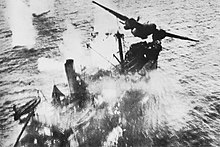
Skip bombing was a low-level bombing technique independently developed by several of the combatant nations in World War II, notably Italy, Australia, Britain, Soviet Union and the United States. It allows an aircraft to attack shipping by skipping the bomb across the water like a stone. Dropped at very low altitudes, the bomb never rises more than about 5 metres (16 ft) above the surface of the water, ensuring that it will hit the side of the ship as long as it is aimed correctly.
As the technique required the aircraft to fly at very low altitudes directly at the ship, it made shooting down the aircraft easier as well. In the immediate pre-war era, there was considerable effort to develop new bombsights that would allow the aircraft to remain at higher altitudes. The most notable was the US Navy's Norden bombsight, which was fitted to most Navy aircraft. In practice, these proved largely useless, and the skip-bombing technique was soon introduced operationally.
After Pearl Harbor (December 1941), it was used prominently against Imperial Japanese Navy warships and transports by Major William Benn of the 63rd Squadron, 43rd Bomb Group (Heavy), Fifth Air Force, United States Army Air Forces in the Southwest Pacific area theater during World War II. General George Kenney has been credited with being the first American to use skip bombing with the U.S. Army Air Forces.[1][2]
Skip bombing was most famously used in Operation Chastise known as the Dambuster raid. This used specially designed barrel shaped bouncing bombs that used backspin to skip along the water and destroy the dams.
- ^ Kuhn, Tom (April 1998). "Ideas That Lift the Air Force". Airman. 42 (4): 8–9. Archived from the original on July 15, 2006. Retrieved October 28, 2012.
- ^ "Biographies : General George Churchill Kenney". United States Air Force. Archived from the original on 2012-07-17. Retrieved October 28, 2012.